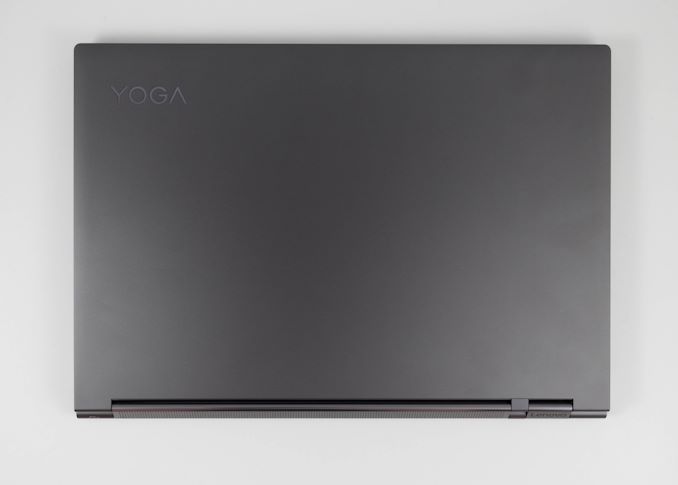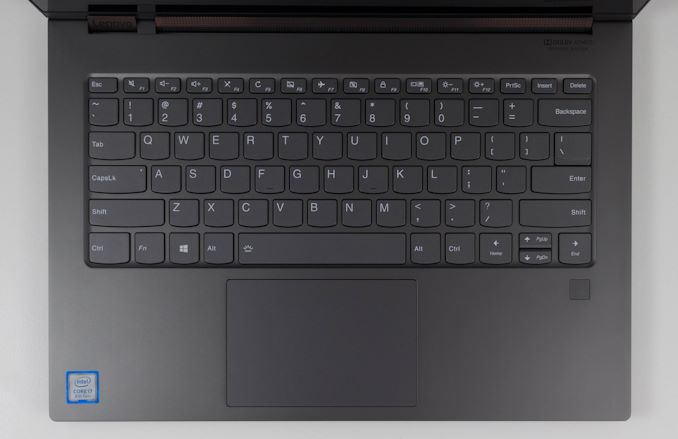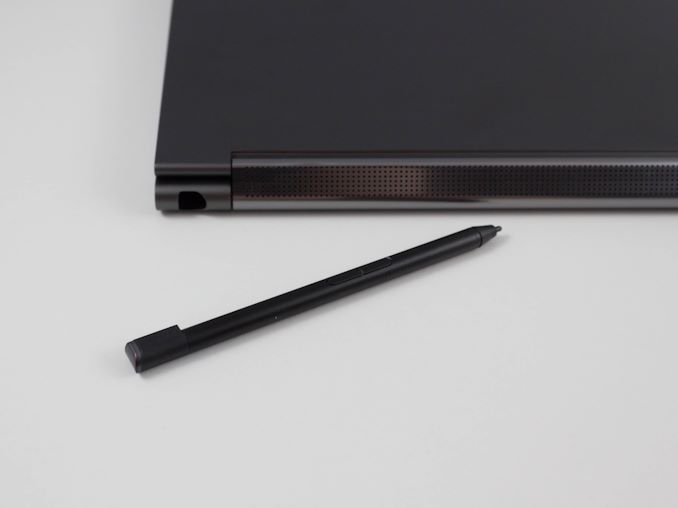The Lenovo Yoga C930 Review: Atmos Acoustics
by Brett Howse on March 1, 2019 8:00 AM ESTDesign
It would be easy to gloss over the fact that this laptop is a convertible with a 360° hinge, because the Yoga-style hinge has pretty much won the market in terms of convertible laptops. And these days, opting for a convertible notebook doesn’t bring much in the way of drawbacks either. If you are in the market for an Ultrabook, there’s almost no downside to opting for a convertible with a Yoga hinge, compared to a typical laptop. When used in their laptop form factor, they offer the same performance and weight distribution you’d expect. But, they add in the option of other modes that even if only rarely used, are downright useful in their own way. If you want to watch a movie on an airplane, you can of course do that with a normal laptop, but the ability to flip the keyboard underneath and use the device in Stand Mode puts you much closer to the screen, and Stand Mode along with Tent Mode offer an immersive experience you’re not going to get with a typical laptop.
Lenovo’s Yoga C930 has a very sleek aluminum design, and the finish is simply superb. The entire device is wonderful to hold, and somehow doesn’t seem to attract fingerprints as easily most notebooks. The back of the device is a muted design, with just the Yoga branding in the top corner. The full-length rubber strips on the bottom provide excellent traction when using it as a laptop, and this is really one of the nicest designs Lenovo has ever come up with. It really is a stunning looking laptop when it’s closed.
Opening it up, the display bezels on the side are thin, although not class-leading. The upper bezel is wide enough to house the webcam in the correct location, which is nice. The bottom bezel is quite large though, and while it is nice to have the display sitting up a bit so your hands don’t cover it when typing, it’s so large that it would have been nice to see a taller aspect ratio display fitted to leverage some of that space. Even in tablet mode you would be unlikely to need that kind of a lip to hang on to.
The keyboard offers six rows of keys, and is laid out as Lenovo typically does, and it works really well. The keys have a nice feel to them when typing, and the two levels of white backlighting contrast well with the dark key caps. The keys are a bit slippery, but they don’t distract form the typing experience,
The trackpad on this notebook is superb, offering a great feel thanks to the smooth glass surface. It offers precise control, and has no issues with multi-touch gestures either. The size is larger than you’d maybe expect in a 14-inch laptop, but not so large that it ever feels awkward.
The left side houses all of the ports, with both USB-C ports for the Thunderbolt 3, and the USB-A port as well. Luckily laptops haven’t yet jumped on the silly train of removing the 3.5mm jacks, and that’s also on the left side. The right side features just the power button, situated on the side of the laptop so that it is usable no matter how the display is situated. The rear of the laptop houses the active pen.
The active pen is not going to be something for artists, and can’t compete with something like the Microsoft Surface Pen or the Apple Pencil, mostly because of the ergonomics of it. It’s very small, very thin, and not as comfortable to hold as any of the larger active pens. What it lacks in ergonomics it does make up for in convenience though, since the pen is always available, and always charged, thanks to the built-in housing. It clicks in and out with a reassuring click, meaning it’s not going to fall off in your bag like something that’s magnetically attached to the side of a device. For note-taking, which is what this pen is really for, the latency and pressure sensitivity is excellent.
The design of the Yoga C930 is fantastic. The build quality is excellent. The device looks and feels absolutely top-notch, and offers the increased versatility of the Yoga hinge allowing for a device that adapts to your usage, rather than you adapting to a device. If there was one complaint, it would be that the bottom display bezel is quite large, but it doesn’t really distract from the experience.
















32 Comments
View All Comments
HStewart - Friday, March 1, 2019 - link
But Intel completion is upper end of laptops is really subpar in performance level. They might want to believe they compete on that level but manufactures understand this and they are not going waste there time - on a product that fans want in mobile industry but they don't buy mobile but instead purchase desktops. There are of course exceptionCHUWI - in my experience with them they are trying to implied that they have high end competitor but actually use the lower end chips. To me this is misleading the customer - to have a Surface Pro looking device with a lower end performance.
Windows for ARM tablets - this is strange part of mobile industry, I personally think a better fit would Chromebooks where native x86 performance is likely not required - but to fool a customer to think they have a full speed notebook to run existing apps is insane. I think they do have limited uses if only web browsing, and Microsoft office applications required. They do have good battery life but the latest generation of notebooks come very close and with Intel Lakefield on the horizon, I believe battery advantage will be gone. But there is not much on this but I believe a combination of 4 low power efficient cores combine with Sunny Cove performance core combine with Gen 11 graphics core - with close to discrete level performance in size of chip that can fit on tip of your finger is going to be quite awesome. This is likely going to remind of days when Intel went from Core 2 to i7 technology.
I loved the EMiB technology and with Lakefield they take it step farther with Foveres technology is going being better. Just image a notebook with more IO on one level, power mult-core logic on next level and high performance discrete GPU on next level. With this technology they could package 100 if not 1000's of cores on desktop size chip.
ChickenLegsxx - Thursday, June 20, 2019 - link
Download Popcorn Time for android from this page https://getpopcorntimeapk.comUpSpin - Friday, March 1, 2019 - link
It the Pen WACOM AES, or N-Trig or Synaptics or ....How does the pen get charged? Inductive in the storage slot? Are you sure? Maybe it's Wacom EMR, as in the Wacom Intuos series/Samsung Galaxy tablets/Samsung Note smartphones, then there's no need to charge the pen at all, because it's coupled inductively with the display.
How good is the accuracy of the pen? Can you draw straight lines or do they wobble?
How is the pressure sensitivity of the pen? How many levels, how sensitive?
Does the pen have an eraser on the back? Does the pen have some buttons? Does the peen offer some other functionality.
How does the pen feel on the display? Is the surface good to write on?
How does the pen perform on the edges of the display?
Please, it's a tablet you can write on, why don't you include this in your review. Just because the delivered pen is small doesn't mean the you can't buy a better larger one afterwards, as long as you know which one. Maybe the HP Active Styli work, or do we need N-Trig?
Brett Howse - Friday, March 1, 2019 - link
It's Wacom AES and feels good on the display and works well. It's not a top-tier stylus but for writing it's great.Thud2 - Friday, March 1, 2019 - link
Are you practicing your typing skills. 300 words to say "What about the pen?"heffeque - Saturday, March 2, 2019 - link
Laughed harder than I should have.Prestissimo - Friday, March 1, 2019 - link
Wacom AES 2.0 technology, 4096 pressure levels, official name is Lenovo Active Pen 2.For compatibility with both Wacom AES and N-Trig / MPP, get the Bamboo Ink Pen which is currently regarded as the best 2-in-1 laptop stylus you can buy.
imaheadcase - Saturday, March 2, 2019 - link
Because most our touch screen and no one uses a pen is why. loleastcoast_pete - Friday, March 1, 2019 - link
@Brett: Thanks for this review. Question: In addition to the soundbar, what kind of audio chipset does this Yoga use? Dolby Atmos usually implies 7+1 or more channels to get the Atmos surround effects. I don't expect that from the built-in speakers, of course, but can this thing provide 7+1 or 9+1 output to amplifiers to really get Atmos surround sound? To member the Atmos branding implies that. Thanks!Brett Howse - Friday, March 1, 2019 - link
Dolby Atmos on PC doesn't require or imply 7+1. Even in the HT world you can get Atmos sound bars. Will it be as immersive as a 7 channel setup with true height speakers? No of course not. But it still provides a wider sound stage from the included speakers in this sound bar.You can get more info from Dolby's website.
The laptop has an Intel audio chipset (SST) and Realtek codec. As for outputting to a receiver, there's no specific digital audio output like HDMI to carry the signal. You'd have to go over the USB/TB3 connections.